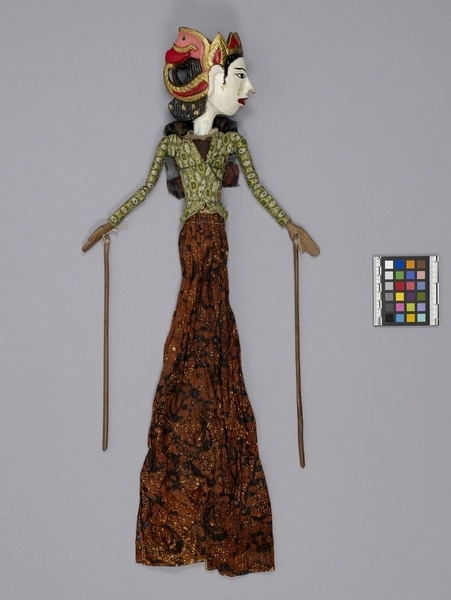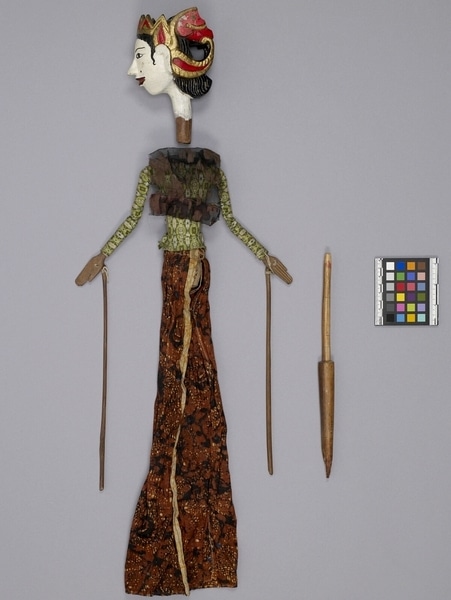Rod Puppet Item Number: Ib281 a-c from the MOA: University of British Columbia


Description
Three-dimensional female humanoid puppet: large head (part b) fits into body with shirt and skirt (part a), and a control rod (part c) with a long shaft passes through the body and fits into the neck of the figure's head. The body has jointed arms, each with a long controlling rod attached. The figure has a white face, red lips, and small black eyes. Black hair pulled back into a bun, headdress of red, gold, some green and pink, including a diadem and an ear ornament (or sumping). Wears a v-neck shirt, long-sleeved bodice with a geometric pattern in dark green, light green, yellow, and off-white with a long, brown gauze collar that extends down the back from the neck. Undershirt in brown. Batik skirt of brown, black and off-white. There is a green, blue, yellow, red and clear glass bead necklace sewn to the front of bodice.
History Of Use
Javanese puppetry as an art form probably developed by the 11th century. The three-dimensional wooden wayang golek puppets of western Java, which are to be distinguished from the earlier and more sacred wayang kulit shadow plays puppets or other forms, appeared during the 16th century. Originally the plays depicted Javanese mythology, but after the Indian conquest of Java the Hindu epics, Ramayana and Mahabharata, were incorporated into the cycles, which comprise about 200 plays. An individual or group hires a dalang (puppet-master) to celebrate important occasions. The performances often last all night and are generally presented in three acts, with vocal and instrumental accompaniment. The individual plays vary widely in detail but usually involve conflict between good and evil. They serve a moral and religious purpose, and more recently, one of political commentary. Each puppet's character is represented by its appearance and placement onstage; protagonists with strong elements of good are placed to the right, antagonists of violent or evil nature to the left.
Cultural Context
Theatrical performance.
Iconographic Meaning
Many features typical of characters of noble descent. White face indicative of youth, innocence. Forward gaze and fine facial features indicate nobility. Headdress with sumping reserved for deities and the royal family; a diadem jamang and a variation of the mythical bird, Garuda, also on headdress- associated with high status. Batik skirt, other finery also shows noble ancestry. Puppet represents the character Srikandi, a woman of high birth.
Item History
- Made in Java, Indonesia
- Owned by Tradewind Antiques before March 15, 1983
- Received from Museum of Anthropology Shop Volunteers (Funding source) and Tradewind Antiques (Seller) on March 15, 1983
What
- Name
- Rod Puppet
- Identification Number
- Ib281 a-c
- Type of Item
- puppet
- Material
- wood, paint and synthetic fibre
- Manufacturing Technique
- carved, painted, machine woven and sewn
- Part A
- height 52.3 cm, width 9.5 cm, depth 4.5 cm
- Part B
- height 16.2 cm, width 7.7 cm, depth 10.4 cm
- Part C
- height 27.7 cm, diameter 1.9 cm
Who
- Culture
- Sundanese
- Previous Owner
- Tradewind Antiques
- Received from
- Museum of Anthropology Shop Volunteers (Funding source) and Tradewind Antiques (Seller)
Where
- Holding Institution
- MOA: University of British Columbia
- Made in
- Java, Indonesia
When
- Ownership Date
- before March 15, 1983
- Acquisition Date
- on March 15, 1983
Other
- Condition
- fair
- Accession Number
- 0886/0015 a-c